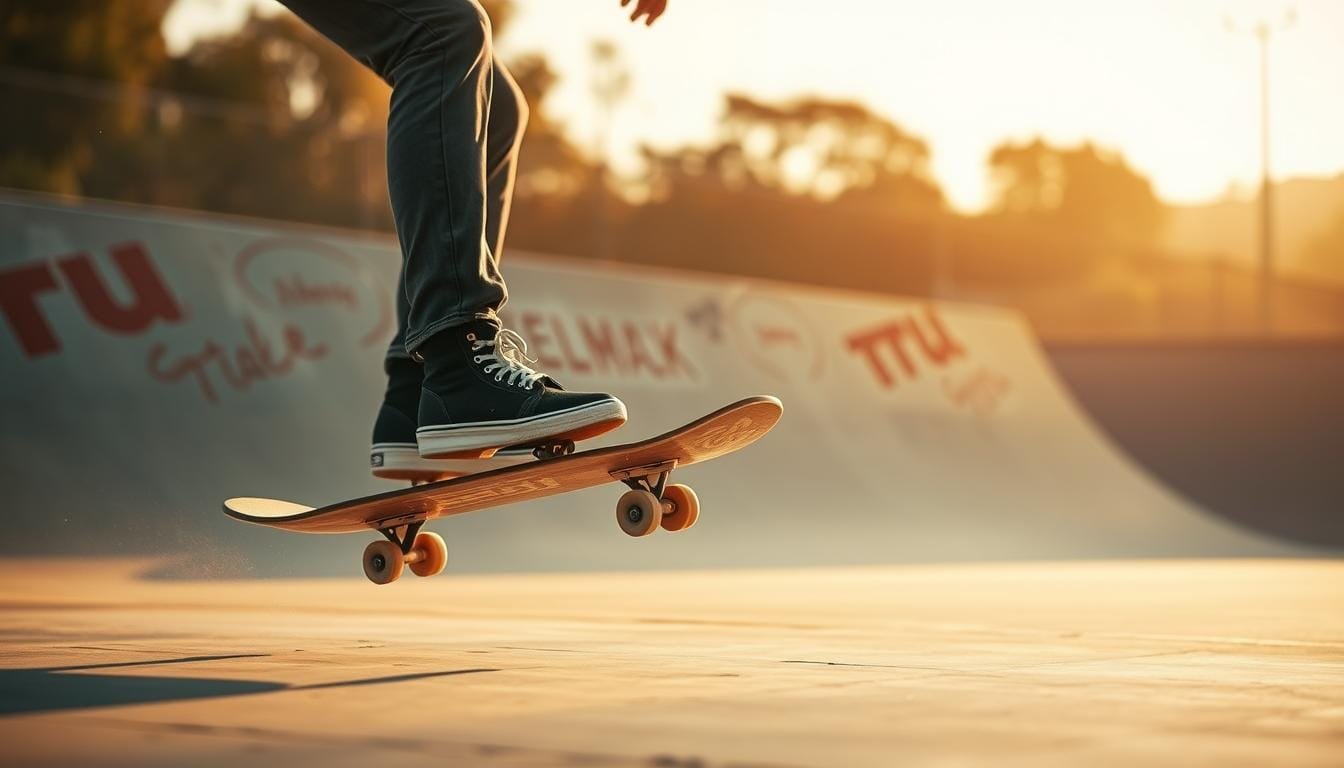Starting with skateboard tricks can be scary for beginners. Yet, the right equipment can change everything. Using the correct skateboard tricks wheels can really help your performance and speed up learning. Soft wheels skateboarding has a lot of benefits. They provide better grip and smoother rides on bumpy surfaces. So, they are a great pick for both new skateboarders and lovers looking to master skateboard tricks more easily and safely.
Knowing the best wheels to use is key to improving your skills. Soft wheels give you the right mix of control and grip for beginner skateboard tricks. Starting with basic skills and moving up gradually is important. It helps avoid getting hurt and builds your confidence. This way, you learn quickly and stay excited about skateboarding.
Key Takeaways
- A structured learning order boosts confidence and helps you progress faster.
- Proper trick learning order reduces injury risks from premature advanced tricks.
- Regularly achieving milestones keeps your motivation high.
- Soft wheels provide better grip, ideal for beginners mastering skateboard tricks.
- Understanding the basics with the right equipment makes trick learning enjoyable.
Understanding Soft Wheels and Their Benefits
Choosing the right skate gear is key, especially when looking at soft skateboard wheels. These wheels have low durometer ratings, under 95A, that help improve your ride. They’re great for certain skate styles and conditions.
Soft wheels grip better on almost every surface. They’re perfect for street skating’s rough areas. Their durometer can go as low as 78A. This softness helps soak up bumps, giving a smoother ride than harder wheels, which are usually 99A to 101A.
Soft wheels are also bigger and made of special materials. They often measure between 54mm and 60mm. This size helps you skate more steadily and feel fewer bumps. Ricta Clouds, for instance, are chosen for their soft outer layer but strong core, ideal for cruising and filming.
Let’s look at the differences between soft and hard wheels to help pick what’s best for you:
| Wheel Type | Durometer Range | Common Uses | Approximate Price |
|---|---|---|---|
| Soft Wheels | 75A to 95A | Cruising, Filming, Longboarding | $35 – $60 |
| Hard Wheels | 99A to 101A and above | Street Skating, Park Skating | $30 – $48 |
| Medium Durometer Wheels | 90A to 98A | Beginners, Rough Street Skating | $40 – $45 |
With this info, you can find the best wheels for your skateboarding. Whether cruising on soft wheels or doing tricks on medium ones, knowing their benefits makes skating much better.
Common Misconceptions About Tricks with Soft Wheels
Many people think soft wheels aren’t good for skateboarding tricks. But, skilled skaters often pick soft wheels for certain tricks because they offer benefits. It’s key to uncover these myths to really understand skateboarding.
Some say soft wheels aren’t great for tricks. But, while hard wheels (95A-101A) are usually chosen for their quick response, soft wheels (70A-87A) shine in other ways. They provide a smoother journey over bumpy paths and better grip for skating down hills or doing transitions.
It’s a common belief that you can’t do jumps or flips with soft wheels. That’s partially false. Even though hard wheels might be better for street skating tricks, soft wheels work better in some conditions. For instance, they make less noise, which is a plus when filming skate videos.
Another myth is that soft wheels wear out faster and aren’t as tough. Actually, soft wheels might wear down quicker during power slides. But they usually last longer on harsh surfaces due to how well they absorb shocks. This shock absorption makes them perfect for smooth cruising and traveling.
Some skaters think soft wheels can’t go fast. But, for downhill skating, softer wheels are a top choice because they grip the road better. Wheels between 88A and 94A can perform well on different surfaces, offering versatility.
Clearing up these myths helps us appreciate the variety in skateboarding. Acknowledging soft wheels’ unique benefits can improve your skateboarding, especially when you need a smooth ride and good control.
Essential Tricks You Can Perform with Soft Wheels
Soft wheels make skateboarding tricks easier and smoother. They are great for all skill levels, especially beginners. Here are some tricks that work well with soft wheels:
Manuals: Manuals are a basic balance trick that improves your skateboarding. You lean back, lift your front wheels, and ride on the back ones. Soft wheels help because they are grippy and stable.
Ollies: The ollie is a must-know trick in skateboarding. Using soft wheels makes learning ollies easier. Just bend your knees, pop the skateboard’s tail, and slide your foot to lift it. The soft wheels help by soaking up the landing shock.
Shuvits: Shuvits require you to spin your board 180 degrees without moving. Soft wheels make landing these spins smoother. You scoop the board’s tail with your foot and jump slightly. This helps the board rotate.
Knowing your wheels well improves your skateboarding. Here’s how different wheels compare:
| Wheel Type | Diameter | Hardness | Best For |
|---|---|---|---|
| Street/Park | 50mm-60mm | 95A-101A | Technical Tricks |
| Cruiser | 54mm-60mm | 78A-90A | Comfortable Rides |
| Longboard | 70mm | 75A-90A | Downhill Stability |
| Vert | 56mm+ | 95A-100A | Ramps and Bowls |
Soft wheels can make learning skateboarding tricks smoother. They help you build skills. So, get your skateboard and start practicing to get better every day!
Techniques to Improve Your Balance and Control
Mastering skateboard tricks needs good balance and control. You can get better through regular practice. Paying attention to how you position your body, where you place your feet, and how you distribute your weight will make a big difference.
To start, having the right stance is crucial. Your weight should be balanced across both feet with knees bent for more agility. Trying out different surfaces will also teach you to adjust your balance, boosting your board control.
Doing certain drills can make a huge improvement. For example, try standing on one foot on your skateboard or practice doing tail and nose stalls. By doing these, you’ll greatly improve your balance, both while moving and standing still.
Getting your foot placement right is also key. Your front foot should be near the bolts, with the back foot near the tail. This helps you move precisely and stay in control.
Here’s a look at how wheel size and hardness affect your balance and control:
| Wheel Size | Best Use |
|---|---|
| 50mm–54mm | Technical tricks, quick acceleration |
| 55mm–59mm | Balanced performance, various environments |
| 60mm and above | Downhill, rough terrain, top speeds |
Choosing the right wheels is crucial whether you street skate, park skate, or cruise. Legends like Tony Hawk and Rodney Mullen say it’s key to match your wheels to your skating style and surface for the best performance.
By using these skate control techniques and focusing on specific practice exercises, you’ll see big improvements in your skateboarding. It’ll boost your skills and confidence on the board.
Choosing the Right Setup for Tricks
Choosing the right skateboard setup is key to mastering tricks. Your choice of deck, trucks, and wheels matters a lot. For street skating tricks, go for smaller wheels (50-54mm) with a hardness of 95-101A. They’re kind of light and respond quickly, making tricks easier.
If you’re starting or skating on rough streets, medium hardness wheels (90A to 98A) are better. They offer a good balance for beginners.
For a smooth ride, cruiser or soft wheels (54-60mm and 78-90A) are ideal. They absorb shocks well. Longboard wheels (60-75mm and 75-85A) are good for faster rides and bowl skating.
With custom skateboards, you can pick what suits you best. If you’re heavier, larger, softer wheels work well for stability. Lighter riders might prefer smaller, harder wheels for agility. Wheel hardness is based on the durometer scale, with 0 being the softest and 100 the hardest. Soft wheels are great for smooth paths, while harder wheels (90A or up) tackle rough surfaces well.
Matching your wheels to your skateboarding activities is vital. For help picking the best wheels, check out these tips.
Keep your skate gear in top shape by regularly cleaning and checking your wheels. For advice on longboard wheels on a skateboard, see this guide.
The perfect setup helps you do tricks with confidence and safety. It should match your skateboarding dreams and goals.
Maintenance Tips for Long-lasting Performance
Taking good care of your skateboard is crucial. It not only makes it perform better but also last longer. Follow these tips to keep your skateboard in great shape.
Regularly Clean Your Wheels and Bearings: Clean your wheels every 2-3 months to avoid dirt buildup. Dirty bearings can make wheels slow and wear out faster. A skateboard bearing cleaning kit is great for keeping them in top shape.
Rotate Your Wheels: Rotating your wheels evenly wears them down, which means they last longer and keep you stable. Do this every 2-3 months.
Inspect for Damage: Check your wheels, bearings, and deck for damage like flat spots or cracks. Choosing the right terrain is important to reduce wear. Look over your deck and trucks once a month to catch any early signs of damage. This helps you stay safe.
Store Properly: Keep your skateboard in a cool, dry place to avoid warping or cracking. Stay away from humid areas to protect your deck.
Maintain Grip Tape: To keep your grip tape sticky, clean it every month. Replace it once a year or as needed but avoid getting it wet. Water can loosen the adhesive and cause peeling.
| Maintenance Task | Frequency |
|---|---|
| Clean Wheels and Bearings | Every 2-3 months |
| Rotate Wheels | Every 2-3 months |
| Inspect for Damage | Monthly |
| Clean Grip Tape | Monthly |
| Replace Grip Tape | Annually or as needed |
| Store Skateboard Properly | Always |
By following these upkeep tips, you’ll keep your skateboard in top condition. Regular care is essential for a smooth, safe ride and for pulling off cool tricks.
Community and Resources for Learning Tricks
Getting into skateboarding means joining a cool community. No matter if you’re new or have skated for years, meeting others helps a lot. Local skate parks are great for making friends and picking up new moves. Watching skilled skaters gives you a quick lesson on tricks and how to act at the park.
Don’t overlook online skate resources, either. Websites like YouTube are packed with skate tutorials, from simple ollies to complex flips. Skaters like Jon Depoian share their expertise through these videos. Their tips have helped over a million viewers learn how to ollie. Regular practice with these guides will boost your skills gradually.
Social media groups and forums are also key. They let you post your progress, seek advice, and get opinions from skaters around the world. This interaction boosts your abilities and keeps you driven. It’s about celebrating wins and learning from losses. Remember, mastering skate tricks is a path better walked with others.

I’m John Peterson, a passionate skater, blogger, and lifelong enthusiast. I’ve been skating for over 9 years and have gone on to write a blog dedicated to the sport of skating and its culture. Through my blog, I strive to share my knowledge and experience of the sport with all who are interested. From beginner tips, tricks, and equipment reviews to interviews and event coverage, I cover it all. So read my blog as I explore the wonderful world of skating!

